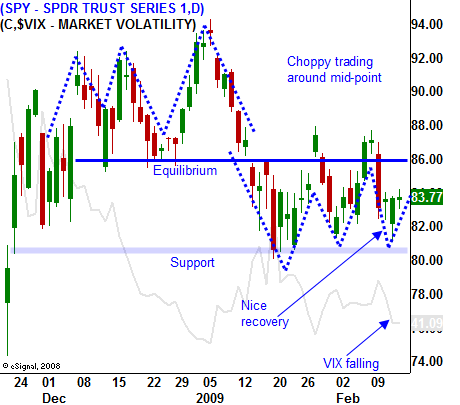SPY 80 Will Be Tested Next Week and It Will Hold!
Yesterday, the market got off to a shaky start when Asia declined overnight. A slightly better-than-expected (but dismal) initial jobless claims number also weighed on traders’ minds. Continuing unemployment claims have almost risen to the 5 million mark. Retail sales came in better than expected and that helped to temper some of the selling.
As you can see in today's chart, the market has been choppy around the middle of the trading range. Equilibrium has formed around SPY 86. When the market rises above that level, it's overbought and sellers feel comfortable shorting the market. When prices drop to the SPY 80 level, buyers feel confident enough to open their wallets.
The market had slipped down to support yesterday and I could feel the bearish momentum waning. In the afternoon, the Obama administration announced a plan to curb mortgage defaults and that was the catalyst the market needed for a reversal. The details of the plan are still being sketched out. If I recall correctly, one version set a limit for the percentage of gross income that an individual could spend on housing. If homeowners were allocating less than 38% of their gross income, the government would provide aid to keep them from going into foreclosure. If the percentage was higher, the risk of default was too high and the taxpayers would not be burdened by loans that should not have been made in the first place.
Three major banks have announced a moratorium on foreclosures. J.P. Morgan Chase said that they would not foreclose on any new properties during the next three weeks. They feel that is enough time for the government to finalize its mortgage bailout plan.
All of these bailout and stimulus plans don't change the fact that we have too much debt and pain lies ahead. The monumental losses from bad investment decisions are simply being shifted from greedy financial institutions and foolish homebuyers to taxpayers. Our national debt is escalating and the cost of capital will rise sharply as we try to fund these programs. For the time being, it's great to dream about how this can all work out. Unfortunately, everything needs to go right for this to happen and the probability is low.
The real dilemma comes down to taking severe pain now and adjusting our way of life or postponing the inevitable through more spending. Unfortunately, the latter will end in a devastating manner. I don't expect a new president to tell the constituents that elected him that we need to swallow a bitter pill now. Americans want to believe that Barack Obama has the answers. I don’t believe he or anyone else does. This nasty cycle has to run its course and decades of overspending can only be reversed by time and saving.
For now, traders want to see if prior actions will bear fruit. Interest rates are low, the Fed has been pumping cash into financial institutions, the money supply is on the rise and credit spreads are starting to narrow. These are all positive signs and the market should find support near its current level.
It's what lies ahead in future months that scares me. Once we start issuing debt, we will see how far we get before interest rates start to climb. Rates are already on the rise in anticipation of what's to come. This will be the largest bond offering our country has ever attempted. We will need to raise more than $1.5 trillion this year. After the first third has been raised, I expect the last two thirds to come at a very high price. The alternative is to have the Fed buy our debt and to artificially keep interests rates low. This process of "printing money" leads to massive inflation and a collapse in the US dollar. Market forces will determine the cost and feasibility of our spending plans.
Personally, I feel that we needed to shore up the banks. If that means nationalizing some of them, so be it. Take all of the shareholder equity to zero. Renegotiate mortgages and take your write-downs based on actual real estate values. Once banks resume normal lending, the profits will come quickly because the spread between the Fed funds rate and the prime rate is so wide. Then, do an IPO and issues shares. Over time, as confidence is restored, continue scaling out of the shares. In a matter of years, this program could breakeven.
The stimulus plan will not achieve its objectives. We already know that from last year’s tax rebate. If we would have used that $500 billion for the banks, we would be in better shape now. The stimulus will simply increase our debt burden and strip us of money that might be needed down the road.
With the market near its one-month lows, option expiration could have a negative bias. Economic reports Wednesday, Thursday and Friday could weigh on investors, but worse case scenarios are already factored in. I believe the SPY 80 level will be tested and it will hold. If that is the case, I will have profited nicely from another round of put selling. With the market near support, I will start scaling into March positions later next week. Although the VIX has been coming down, it is still at historically high levels and option premiums are rich. The market is comfortable pivoting around SPY 86 and that plays right into my hand.


Daily Bulletin Continues...

